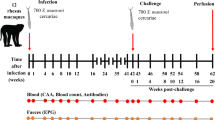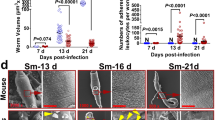Abstract
HUMAN immune responses to schistosome infection have been characterized in detail1–5. But there has been controversy6 over the relative importance of ecological factors (variation in exposure to infection) and immunological factors (acquired immunity) in determining the relationships between levels of infection and age typically found in areas where infection is endemic7,8. Independent effects of exposure and age on the rates of reinfection with Schistosoma haematobium after chemotherapy have been demonstrated in the Gambia9 and Zimbabwe8. This age effect could be the result of acquired immunity to infection. Indeed, allowing for variation in exposure and age, low rates of reinfection in the Gambia are correlated with high amounts of specific IgE antibodies10―human IgE can kill S. mansoni schistosomulae in vitro11. Further, animals can acquire immunologically mediated resistance to S. mansoni infection12–14, although nonimmunological factors could also be involved15. Acquisition of this immunity seems to be related to the cumulative effects of repeated infection and provides only partial protection12,13,16. These characteristics are consistent with immuno-epidemiological data for both S. mansoni and S. haematobium infections of humans4,17. We have now analysed age–prevalence data for human infection with S. haematobium, and find patterns of variation that are indeed consistent with the epidemiological effects of acquired immunity predicted by mathematical models.
This is a preview of subscription content, access via your institution
Access options
Subscribe to this journal
Receive 51 print issues and online access
$199.00 per year
only $3.90 per issue
Buy this article
- Purchase on Springer Link
- Instant access to full article PDF
Prices may be subject to local taxes which are calculated during checkout
Similar content being viewed by others
References
Sturrock, R. F. et al. Trans. R. Soc. trop. Med. Hyg. 77, 363–371 (1983).
Butterworth, A. E. et al. Trans. R. Soc. trop. Med. Hyg. 79, 393–408 (1985).
Butterworth, A. E. et al. Parasitology 94, 281–300 (1987).
Hagan, P. et al. Trans. R. Soc. trop. Med. Hyg. 81, 938–946 (1987).
Dunne, D. W. et al. Eur. J. Immun. 18, 123–131 (1988).
Wilkins, H. A. in Biology of Schistosomes (eds Rollinson, D. & Simpson, A. J. G) 379–398 (Academic, London, 1987).
Wilkins, H. A., Goll, P. H., Marshall, T. F. & Moore, P. J. Trans. R. Soc. trop. Med. Hyg. 78, 216–221 (1984).
Chandiwana, S. K., Woolhouse, M. E. J. & Bradley, M. Parasitology 102, 73–83 (1991).
Wilkins, H. A., Blumenthal, U. J., Hagan, P., Hayes, R. J. & Tulloch, S. Trans. R. Soc. trop. Med. Hyg. 81, 29–35 (1987).
Hagan, P., Blumenthal, U. J., Dunn, D., Simpson, A. J. G. & Wilkins, H. A. Nature 349, 243–245 (1991).
Capron, A., Dessaint, J. P., Capron, M., Ouma, J. H. & Butterworth, A. E. Science 238, 1065–1072 (1987).
Smithers, S. R. & Terry, R. J. Trans. R. Soc. trop. Med. Hyg. 61, 517–533 (1967).
Dean, D. A. Expl Parasit. 55, 1–104 (1983).
Pearce, E. J. & McLaren, D. J. Parasitology 87, 465–479 (1983).
Wilson, R. A. Parasit. Today 6, 354–358 (1990).
James, S. L. & Cheever, A. W. Parasitology 91, 301–315 (1985)
Hagan, P. in Biology of Schistosomes (eds Rollinson, D. & Simpson, A. J. G) 295–320 (Academic, London, 1987).
Crombie, J. A. & Anderson, R. M. Nature 315, 491–493 (1985).
Anderson, R. M. & May, R. M. Nature 315, 493–496 (1985).
Clarke, V. de V. C. Afr. J. Med. 12, Suppl., 1–30 (1966).
Anderson, R. M. in Clincial Tropical Medicine and Communicable Diseases Vol. 2 (ed. Mahmoud, A. A. F.) 279–300 (Bailliere Tindall, London, 1987).
Chandiwana, S. K. Soc. Sci. Med. 25, 495–505 (1987).
Chandiwana, S. K. & Christensen, N. O. Trop. med. Parasit. 39, 187–193 (1988).
Butterworth, A. E. & Hagan, P. Parasit. Today 3, 11–16 (1987).
Doenhoff, M. J., Hassounah, O., Murare, H., Bain, J. & Lucas, S. Trans. R. Soc. trop. Med. Hyg. 80, 503–514 (1986).
Taylor, P., Chandiwana, S. K. & Matanhire, D. Acta Trop. 47, 91–100 (1990).
Taylor, P., Chandiwana, S. K. & Matanhire, D. Community Based Schistosomiasis Control in Zimbabwe (IDRC, Canada, in the press).
Author information
Authors and Affiliations
Rights and permissions
About this article
Cite this article
Woolhouse, M., Taylor, P., Matanhire, D. et al. Acquired immunity and epidemiology of Schistosoma haematobium. Nature 351, 757–759 (1991). https://doi.org/10.1038/351757a0
Received:
Accepted:
Issue Date:
DOI: https://doi.org/10.1038/351757a0
This article is cited by
-
Determining the optimal strategies to achieve elimination of transmission for Schistosoma mansoni
Parasites & Vectors (2022)
-
Vaccination or mass drug administration against schistosomiasis: a hypothetical cost-effectiveness modelling comparison
Parasites & Vectors (2019)
-
Oesophageal varices, schistosomiasis, and mortality among patients admitted with haematemesis in Mwanza, Tanzania: a prospective cohort study
BMC Infectious Diseases (2014)
-
Proportions of CD4+ memory T cells are altered in individuals chronically infected with Schistosoma haematobium
Scientific Reports (2012)
-
Modelling age-heterogeneous Schistosoma haematobium and S. mansoni survey data via alignment factors
Parasites & Vectors (2011)
Comments
By submitting a comment you agree to abide by our Terms and Community Guidelines. If you find something abusive or that does not comply with our terms or guidelines please flag it as inappropriate.



